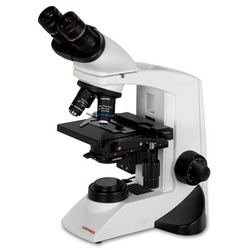Binocular microscopes, equipped with two eyepieces for comfortable, accurate viewing, are essential tools in laboratories worldwide. They allow researchers, clinicians, and educators to explore a wide variety of samples with precision and detail. In this article, we’ll cover the key types of Laboratory Binocular Microscopes their features, applications, and factors to consider when selecting the right microscope for your needs.
1. Compound Binocular Microscopes
Compound binocular microscopes are the most common microscopes in laboratories, known for their high magnification and detailed visualization of cells, tissues, and microorganisms. They use multiple lenses to magnify samples, often up to 1,000x or even 2,000x, making them ideal for cell biology, histology, and microbiology.
Applications:
- Medical and Biological Research: For examining blood cells, bacteria, and tissues.
- Education: Common in classrooms and labs for teaching biology, anatomy, and pathology.
- Clinical Diagnostics: Used in hospitals and clinics to identify various pathogens and cellular abnormalities.
Key Features:
- High Magnification: Provides a detailed view of microscopic structures.
- Illumination Systems: LED or halogen lighting, often with adjustable brightness.
- Objective Lenses: Usually has 3-4 lenses of varying magnifications (e.g., 4x, 10x, 40x, 100x oil immersion).
The compound microscope’s design and powerful magnification make it a staple in laboratories focused on cellular-level studies.
2. Stereo Binocular Microscopes
Stereo microscopes, also known as dissecting microscopes, provide a three-dimensional view of larger, solid specimens at lower magnifications, usually between 10x and 80x. This type of binocular microscope is perfect for examining the surface details of objects without the need for sample preparation.
Applications:
- Dissection and Surgery: Widely used for small-animal dissection and certain surgical procedures.
- Entomology and Botany: Essential for examining insects, plants, and small organisms in life sciences.
- Industrial and Quality Control: Frequently used for inspecting circuit boards, watch components, and other intricate machinery.
Key Features:
- 3D Visualization: Offers depth perception due to angled eyepieces.
- Zoom Feature: Adjustable zoom enables a range of magnifications.
- Flexible Lighting Options: Dual light sources (top and bottom) to illuminate specimens as needed.
Stereo binocular microscopes are indispensable for tasks that require depth perception and a broader field of view.
3. Inverted Binocular Microscopes
Inverted binocular microscopes have a unique design where the objectives are positioned below the stage, facing upwards. This configuration is beneficial for observing samples in containers like petri dishes or culture flasks. Inverted microscopes are commonly used in cell culture and live-cell imaging.
Applications:
- Cell Culture: Ideal for observing live cells growing in media.
- Tissue Engineering: Used in labs for examining larger cell aggregates and tissue cultures.
- Pharmaceutical Research: Essential for drug testing on live cell cultures.
Key Features:
- Bottom-Up Observation: Objectives positioned beneath the stage make it easier to view cells in liquid media.
- High-Resolution Imaging: Allows clear visualization of cells without disrupting the culture environment.
- Sturdy Design: Accommodates large culture vessels and ensures stability.
Inverted microscopes are critical in cell biology labs, allowing for real-time observations of live cell behavior in their natural environment.
4. Polarizing Binocular Microscopes
Polarizing microscopes are designed for examining birefringent specimens—meaning they split light into two rays, such as crystals, minerals, and polymers. These microscopes employ polarized light and are often equipped with rotating stages, making them suitable for materials science and geology.
Applications:
- Geology and Mineralogy: For identifying and studying mineral and rock samples.
- Forensic Science: Used in forensic labs to identify fibers, crystals, and other trace evidence.
- Pharmaceuticals: To examine crystalline structures in drug formulations.
Key Features:
- Polarized Light System: Allows for the study of birefringent materials with enhanced contrast.
- Rotatable Stage: Enables multi-angle viewing of the sample.
- Interference Colors: Offers detailed views of birefringent specimens by displaying them in distinctive interference colors.
Polarizing binocular microscopes are invaluable for fields that require precise analysis of materials with unique light-interacting properties.
5. Fluorescence Binocular Microscopes
Fluorescence microscopes are advanced instruments that use high-intensity light to excite fluorescent molecules in a sample, allowing scientists to observe structures labeled with fluorescent dyes. This type of microscope is widely used in molecular biology, genetics, and immunology for studying cells, tissues, and microorganisms in high detail.
Applications:
- Cell Biology: Essential for identifying specific proteins, organelles, and cell structures.
- Genetic Research: Used to visualize genetic material with fluorescent tagging.
- Medical Diagnostics: Commonly employed to detect certain pathogens and diseases at the molecular level.
Key Features:
- High-Intensity Light Source: Often uses LED or mercury vapor lamps for excitation.
- Multiple Filter Cubes: Enables switching between different fluorophores for multicolor imaging.
- High Sensitivity: Provides sharp contrast, highlighting fluorescent-tagged structures with precision.
Fluorescence microscopes are powerful tools in molecular research and diagnostics, offering insights into biological processes at the cellular and molecular levels.
6. Digital Binocular Microscopes
Digital binocular microscopes integrate a camera and digital display, allowing users to capture, record, and share images in real time. These microscopes are highly versatile and used across various disciplines, from education to industrial inspection and research. Blood Bank Refrigerated Centrifuge
Applications:
- Education: Perfect for classroom use, allowing live demonstrations to be projected for groups.
- Documentation and Analysis: Commonly used to document and analyze specimens digitally.
- Industrial Quality Control: Used in industries for inspecting tiny parts and components.
Key Features:
- Built-In Camera and Display: Captures images and streams video in real time.
- USB and HDMI Connectivity: Enables connection to computers or monitors.
- Software Integration: Often includes analysis software for measurements, annotations, and data storage.
Digital microscopes bring versatility to laboratory work, enabling easy documentation and broader collaboration in research and education.
Choosing the Right Binocular Microscope for Your Needs
Selecting the right microscope depends on your specific application. For instance:
- If you work in clinical or biological research, a compound or fluorescence microscope will be essential.
- For industrial applications or material sciences, a stereo or polarizing microscope may be ideal.
- If you work with live cell cultures, consider an inverted microscope.
- For education and collaborative environments, digital microscopes are highly beneficial.
Key factors to consider include:
- Magnification and Resolution Requirements: Depending on the level of detail needed.
- Sample Type: Different microscopes suit different types of samples (e.g., 3D objects, living cells, or birefringent materials).
- Budget and Features: Advanced features like digital imaging and fluorescence can affect cost but offer high utility.
Understanding the types of laboratory binocular microscopes allows you to make an informed decision, ensuring you have the best tool for your scientific exploration and discovery.
For more blog visit us : www.nciphabr.co.in/





More Stories
Why Choose Oxford Center Best Training Courses in Kuala Lumpur?
The Ultimate Guide to Premium Hand Wash by Salt and Mud
High Speed Doors Servicing Edinburgh: Why It Matters